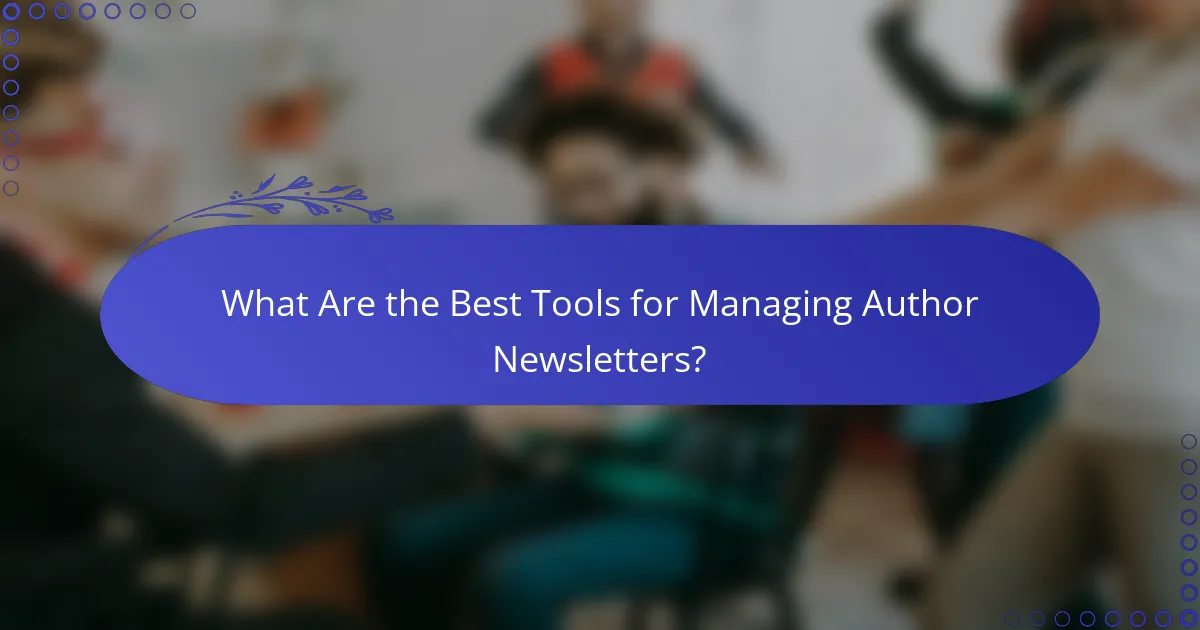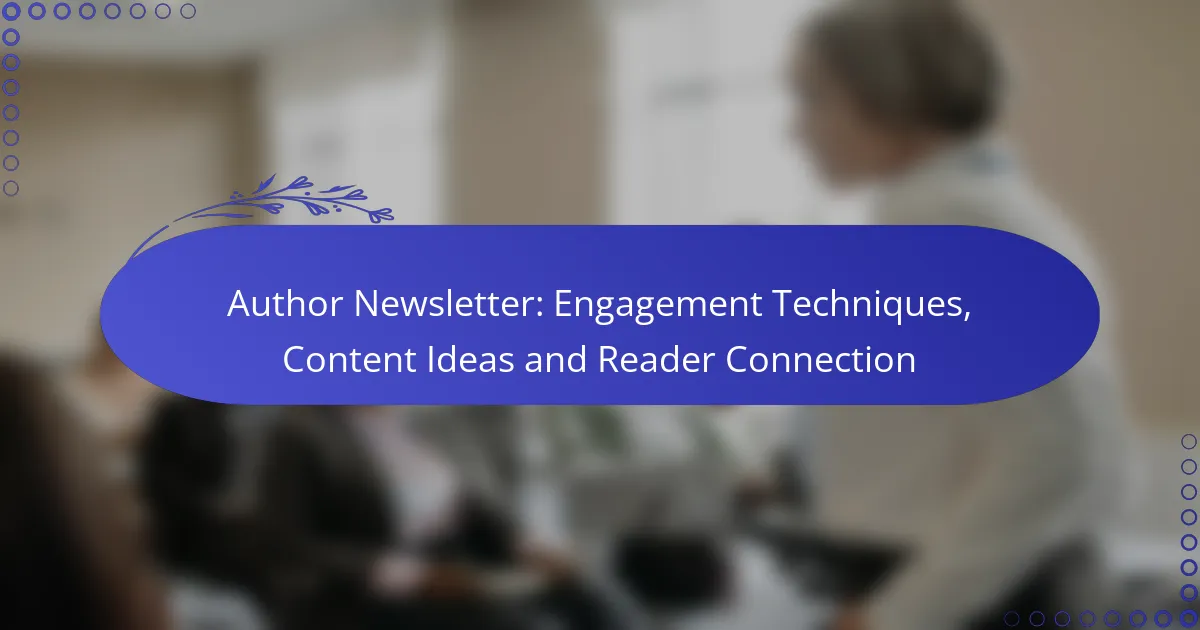Enhancing engagement in your author newsletter is key to building a loyal readership. By delivering tailored content, incorporating interactive elements, and maintaining a consistent schedule, you can foster a deeper connection with your audience. Explore effective content ideas that resonate with your readers and utilize various channels to create a vibrant community around your work.

How to Increase Engagement in Author Newsletters?
To increase engagement in author newsletters, focus on delivering tailored content that resonates with your audience. Incorporating interactive elements and maintaining a consistent schedule can significantly enhance reader connection and retention.
Personalized Content Strategies
Personalization is key to making your newsletter feel relevant to each subscriber. Use data such as past reading preferences or demographic information to tailor content, ensuring it aligns with the interests of different segments of your audience.
Consider including personalized greetings or recommendations based on previous interactions. For example, if a reader enjoyed a specific genre, highlight new releases or articles related to that genre in their newsletter.
Interactive Elements
Adding interactive elements can transform a passive reading experience into an engaging one. Incorporate polls, quizzes, or surveys that invite readers to share their opinions or preferences.
For instance, a simple poll asking subscribers to vote on the next book you should write can foster a sense of involvement. Additionally, consider including clickable elements that lead to exclusive content or additional resources.
Consistent Scheduling
Establishing a consistent schedule for your newsletters helps set reader expectations and builds anticipation. Whether you choose to send newsletters weekly, bi-weekly, or monthly, stick to this timeline to create a reliable rhythm.
Communicate your schedule clearly, and consider using reminders or countdowns for special editions or events. Consistency not only boosts engagement but also reinforces your brand’s reliability.
Exclusive Offers for Subscribers
Offering exclusive deals or content to your newsletter subscribers can significantly enhance engagement. This could include early access to new releases, special discounts, or unique content not available elsewhere.
For example, consider providing a free chapter of your upcoming book or a discount on merchandise. Highlight these offers prominently in your newsletters to encourage sign-ups and maintain interest.
Utilizing Reader Feedback
Actively seeking and utilizing reader feedback can strengthen your connection with your audience. Encourage subscribers to share their thoughts on your content and what they would like to see in future newsletters.
Implementing feedback shows that you value your readers’ opinions and are committed to improving their experience. Regularly highlight changes made based on subscriber suggestions to reinforce this connection and encourage ongoing dialogue.

What Content Ideas Work Best for Author Newsletters?
Effective content ideas for author newsletters engage readers and foster a deeper connection. Focus on providing valuable insights, recommendations, and updates that resonate with your audience’s interests and preferences.
Behind-the-Scenes Insights
Sharing behind-the-scenes insights allows readers to connect with you on a personal level. Consider discussing your writing process, the challenges you face, or the inspiration behind your latest project. This transparency can create a sense of intimacy and loyalty among your audience.
For example, you might share a photo of your writing space or a snippet of an early draft to illustrate your creative journey. This not only humanizes you as an author but also invites readers to become part of your story.
Book Recommendations
Including book recommendations in your newsletter can provide value to your readers while showcasing your expertise. Curate a list of books that align with your genre or themes, offering brief descriptions and personal insights on why you recommend them.
Consider categorizing recommendations by genre or mood, such as “Must-Reads for Fantasy Lovers” or “Inspirational Non-Fiction.” This approach helps readers discover new titles and enhances their reading experience.
Writing Tips and Resources
Sharing writing tips and resources can position you as a knowledgeable figure in the literary community. Offer practical advice on aspects like character development, plot structure, or editing techniques. This not only helps aspiring writers but also engages readers interested in the craft of writing.
You might include links to helpful articles, writing tools, or workshops. A simple checklist of common writing pitfalls can also provide actionable guidance for your audience.
Upcoming Events and Appearances
Keep your readers informed about upcoming events and appearances to foster a sense of community. Whether it’s a book signing, a virtual reading, or a literary festival, sharing these details encourages readers to participate and connect with you in person.
Include dates, locations, and any registration information. You can also highlight any special activities, such as Q&A sessions or giveaways, to generate excitement and encourage attendance.

How to Build a Strong Connection with Readers?
Building a strong connection with readers involves engaging them through various channels and creating a sense of community. This can be achieved by utilizing social media, establishing forums for discussion, and responding personally to reader inquiries.
Engagement through Social Media
Social media platforms are powerful tools for connecting with readers. By sharing content, updates, and behind-the-scenes insights, authors can foster a more personal relationship with their audience. Regular interaction through comments and messages can enhance this connection.
Consider using platforms like Twitter, Instagram, or Facebook to post engaging content that resonates with your readers. Polls, questions, and live Q&A sessions can also encourage participation and feedback, making readers feel valued and involved.
Creating a Community Forum
A community forum provides a dedicated space for readers to interact with each other and the author. This can be set up on your website or through platforms like Discord or Reddit. Forums encourage discussions around your work and related topics, enhancing reader engagement.
To create a successful forum, establish clear guidelines for interaction and encourage members to share their thoughts and experiences. Regularly participating in discussions can help you maintain a strong presence and show readers that their input matters.
Personalized Responses to Reader Queries
Responding personally to reader queries can significantly strengthen your connection with them. Acknowledging questions or comments with tailored responses shows that you value their input and are invested in their experience.
Set aside time each week to reply to emails, comments, or messages. Consider creating a FAQ section based on common queries to streamline responses while still addressing individual concerns. This approach not only builds rapport but also encourages more readers to reach out.

What Metrics Should You Track for Newsletter Success?
To measure newsletter success, focus on key metrics that indicate engagement and growth. Tracking open rates, click-through rates, and subscriber growth rate provides insights into how well your content resonates with your audience and how effectively you are expanding your reach.
Open Rates
Open rates reflect the percentage of subscribers who open your newsletter. A typical open rate for most industries ranges from 15% to 25%, but this can vary based on your audience and content quality. To improve open rates, consider crafting compelling subject lines and sending newsletters at optimal times for your readers.
Be cautious of factors that can negatively impact open rates, such as excessive use of spammy words or inconsistent sending schedules. Regularly analyze your open rates to identify trends and adjust your strategies accordingly.
Click-Through Rates
Click-through rates (CTR) measure the percentage of readers who click on links within your newsletter. A good CTR typically falls between 2% and 5%, depending on the industry and content type. To enhance CTR, ensure your calls to action are clear and enticing, and that your content provides real value to your readers.
Monitor which links receive the most clicks to understand what interests your audience. Avoid cluttering your newsletter with too many links, as this can overwhelm readers and reduce overall engagement.
Subscriber Growth Rate
The subscriber growth rate indicates how quickly your newsletter audience is expanding. A healthy growth rate is usually between 5% and 10% per month, but this can vary based on your marketing efforts and content appeal. To boost your growth rate, utilize social media, referral programs, and incentives for new subscribers.
Regularly evaluate your subscriber acquisition strategies and be mindful of churn rates, which can affect overall growth. Aim to maintain a balance between attracting new subscribers and retaining existing ones to ensure sustainable growth.

What Are the Best Tools for Managing Author Newsletters?
The best tools for managing author newsletters streamline communication, enhance engagement, and simplify the process of reaching your audience. Popular options include Mailchimp, Substack, and ConvertKit, each offering unique features tailored to different author needs.
Mailchimp for Automation
Mailchimp is renowned for its automation capabilities, allowing authors to set up automated email sequences based on subscriber behavior. This means you can send welcome emails, follow-ups, or targeted content without manual intervention, saving time and ensuring consistent communication.
Consider using Mailchimp’s segmentation features to tailor your messages. For instance, you can create groups based on interests or engagement levels, ensuring that your readers receive content that resonates with them. This targeted approach often leads to higher open and click-through rates.
Substack for Monetization
Substack is an excellent platform for authors looking to monetize their newsletters through subscriptions. It allows you to offer free content while charging for premium posts, making it easy to generate revenue from your writing.
When using Substack, consider offering a mix of free and paid content to attract a larger audience. You can start by providing valuable insights or exclusive content to subscribers who pay a monthly fee, typically ranging from $5 to $15. This model encourages reader loyalty and can create a sustainable income stream.
ConvertKit for Segmentation
ConvertKit excels in its segmentation capabilities, enabling authors to categorize subscribers based on their preferences and behaviors. This allows for highly personalized email campaigns, which can significantly improve engagement rates.
To effectively use ConvertKit, create tags for different subscriber interests, such as genre preferences or engagement history. This way, you can send targeted newsletters that cater to specific groups, increasing the likelihood of interaction and fostering a deeper connection with your readers.
